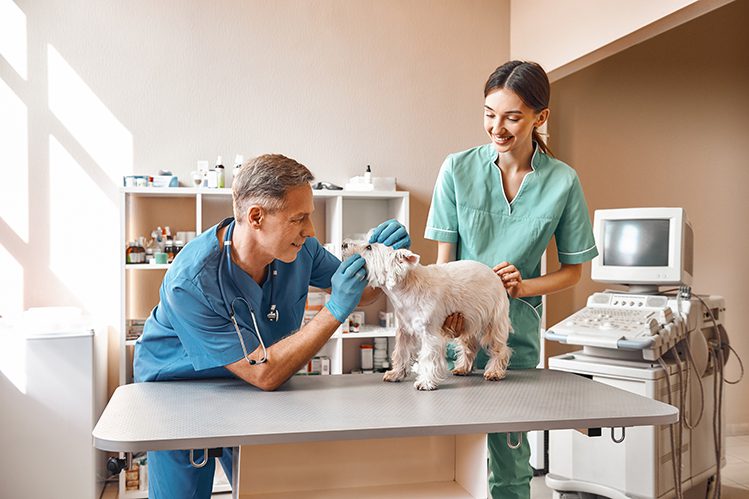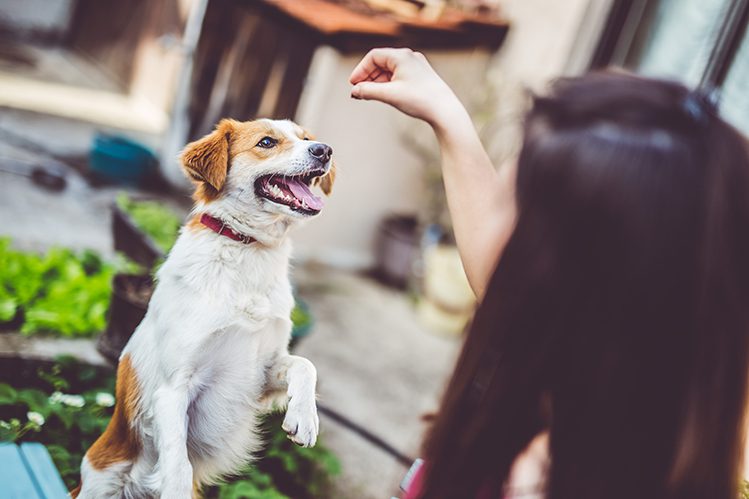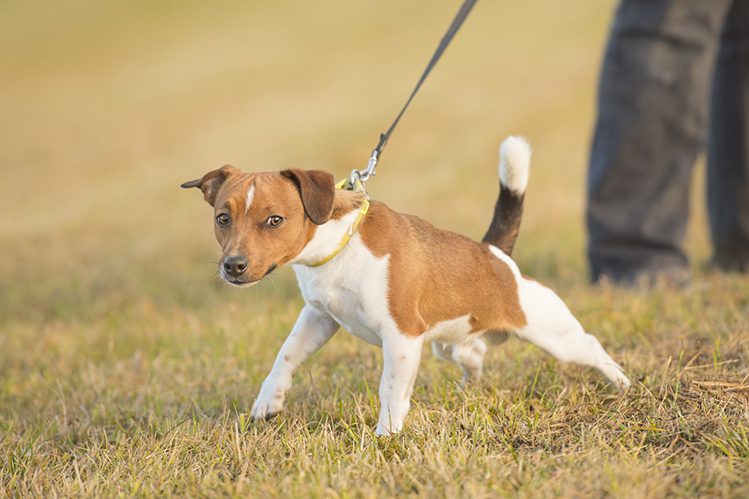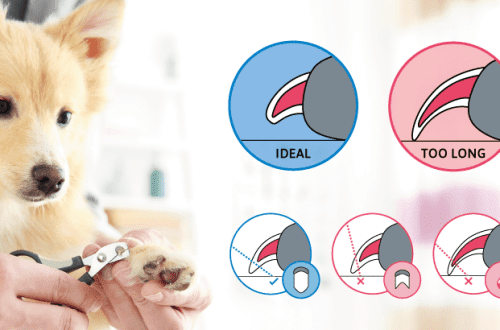
How to teach a dog to stand?
The “Stand” command can be attributed to those that should be learned with a pet as a puppy. We will tell you how to teach your four-legged friend this command and list the problems that may arise in the process of training with a pet.
Benefits of the Stand Team
How to teach a dog to stand in a show stance is one of the first questions that a pet owner with good show potential asks himself. However, the ability to stand upright is useful not only at competitions, exhibitions, and competitions. The stand will be useful during combing wool, trips to the groomer, examinations by a veterinarian.
What do we mean by rack? The dog stands on four legs, the front legs are perpendicular to the floor and parallel to each other, standing on one straight line. The hind legs are laid back, it is desirable that they are parallel to each other, and the metatarsals are perpendicular to the floor. It is allowed that one of the hind legs, the one farthest from the judge, be placed under the body of the dog. Head and tail are parallel to the floor. No need for the pet to lift its head. It is enough for your ward to keep his head straight and look straight. Or an expert, if we are talking about an exhibition. The tail in the rack does not need to be specially lowered or lifted up, its natural position will do.
You can start learning the stance as early as two months old. By nine months, the puppy should be able to stand upright for one to two minutes without any problems. An adult patient, trained pet can stand in the rack, if necessary, for five or ten minutes. It is important to work out not only the command itself, but also a calm attitude to the fact that in the rack the dog can look into the teeth, examine the paws. These manipulations on the part of the groomer, veterinarian, expert at the exhibition should not cause discomfort to the pet, should not make him forget about the stand.

We train the rack
In the online space, you can find many videos and articles on how to teach a dog to stand. Each handler, trainer, dog breeder has his own individual approach. We have compiled recommendations for you that will help you learn the command with both a small puppy and an adult large breed pet.
For small puppies and dogs of small breeds, you can stop at the option with a manual rack. Train your pet even at home, you will need a table with a rubberized mat laid on it. Fasten the ring loosely on the pet’s neck, just below the ears. Take the puppy with your left hand gently under the lower jaw, with your right hand – by the lower abdomen, transfer to the mat. Raise your ward and let the pet feel with its hind legs where the rug ends, where the table ends. This will already force the pet not to back away. Place your pet on the mat so that the hind legs immediately stand up as needed, that is, parallel to each other. Then we correct the setting of the paws with our hands, hold the head and tail with our hands.
If the dog begins to act up, does not begin to perform the exercise, calmly put it on the mat again. Adjust the paws again, hold the head and tail. Make sure that the pet stands in the right position for at least a few seconds. When the pet has turned out to be a stand, you should praise him, stroke him and give him a treat. Let your ward understand that treats and praise will only come when he has been standing for a while. Only when the pet is good at standing, fix the work with the verbal command “Stand!”.
When the pet is confident in the rack, ask someone from the household to come up and stroke the four-legged friend, look into the teeth, examine the paws. This is how you begin to teach your ward to react calmly to examinations of the teeth, coat and limbs at the veterinarian, at the groomer and at competitions. Then you can move with the rug to the floor and rehearse the rack with a small pet again. Remember that it is important to work with your ward in different parts of the house, as well as on the street, including in crowded places (parks, squares). It is important for the dog to get used to the fact that you are doing, repeating commands not only in a certain place at home.
It is better to train a larger dog in a free stance. The following conditions can be called the most suitable: you are standing in front of the dog, he is standing and looking at you, and behind the dog a mirror or a showcase is a good reflective surface in which you can control whether the pet puts its hind legs correctly. If it is possible to film a lesson with a dog, this will help to assess mistakes from the outside and correct them. During the entire workout, be calm and relaxed. Spend the lesson silently, give your voice only the commands that you have learned.
Put on the dog show ring so that it does not put pressure on the neck. Play with your dog for a couple of minutes to arouse activity and interest in it. Call the dog, lure with a treat, but do not give a treat while the dog is sitting, marking time. When the dog has been in a standing position for a couple of seconds, give a treat. Repeat this step. Let the dog learn that he will only see the treat when he freezes in a standing position. When she has repeated it several times without error, say “Stand!” to associate a certain behavior with a verbal command. We give the command only when the dog has managed to fix itself in the correct position.
Now train your pet to stay in place when you step back with one foot. Remember, you always need to step back with the same foot so that the dog does not get confused. If you hand the dog a treat, step back, and the dog takes a step behind you, you are not encouraging this behavior. Wait for the dog to obediently try to stay put in an effort to get a treat. Give a treat. Then, similarly, work out the moment when you step back with not one, but two legs. When you return to your starting position, give your dog a treat. The correct fulfillment of the requirements by the dog can be fixed by the command “Wait!”
Then we teach the dog in the rack to look into your eyes. We wait until the dog looks up at you, we give a treat. The next treat should be given after the dog has looked at you for a few seconds. Make sure your dog is looking into your eyes, not at the treat in your hand. When the dog has been looking into your eyes for a long time, we fix this with the command “Eyes!” (or any other word convenient for you).
It remains only to fix the paws of the pet. The dog distributes the mass of its body on its paws in relation to how its head is located in space. We carefully take the head of the pet in our hands, change the position of the head a little bit, millimeter by millimeter, and observe the changing position of the paws in a mirror image. As soon as the dog stands up properly, you give him a treat.
Let go of the dog’s head. And show your pet that you have a treat in your hands. Slightly change the position of the hand so that the dog, which reaches for the treat, turns its head and changes the position of its paws. Once you have achieved the desired head turn and paw position, give the treat.
No matter how amazing your dog’s stamina is, don’t force your dog to stand for too long. Three minutes is enough. If you have already made sure that your ward performs the rack perfectly, give him another command, otherwise the pet will think that you need to continue to show endurance in the rack. Command “Walk!”, and the pet will already know that the exercise has been completed, you can relax. Ideally, you need to finish the lesson when the pet is not bored yet, has not tired him.
There is a dog trainer to practice the stance. It is usually a wooden box with four props that can be moved around to fit your dog’s size. If you decide to use such a simulator in your classes with your pet, first of all, remember the safety rules. Do not leave your pet alone when he is on the stands.

Possible problems
On average, to achieve a good result, it is enough to practice about 15 minutes daily for two weeks. Subsequently, it is desirable to consolidate the result, devoting several minutes to repeating commands every day. But all dogs are different. Someone is a real child prodigy, demonstrates miracles of obedience, and someone wants to show his character.
Difficulties can arise during the learning process. One of the most common is that the dog lies down and is not even going to get up, let alone stand up. This is where the treat comes in handy. Hold it in your hand, let your pet sense that you have a treat, then remove the hand with the treat from the pet’s face, so that he has to stand up to get closer to the goodies. If this technique does not work, think, maybe the delicacy you have chosen is not tasty enough?
How to teach a dog to stand in a stance without moving his legs? If the pet steps over in a stance, you need to immediately correct the execution of the command. Lead the dog along with the treat, command “Stop!”, Take the hand with the treat away from the pet’s face. If the dog rearranges its paws, walks for a treat, command “No!” And only when the pet stands still, give a treat, saying “Stand still, well done!”
If your pet is not a food eater, the promise of a treat will not make him learn commands. You can train by getting the dog’s attention with a toy. It happens that the dog does not obey at all and does not want to follow the commands. Turn around and leave, do not pay attention to the dog for 15-20 minutes, after three or four hours you can return to classes.
Another common problem is the “Stand!” command. they didn’t learn it with the puppy in time, the dog is already an adult and knows all the commands except this one. Attempts to teach the stand to an adult pet were unsuccessful. Do not give up. Watch training videos from professional handlers, try to figure out how best to adjust your pet training methodology. Work out with your four-legged friend again, be patient. Often, disobedience occurs due to the fact that the owner during the lesson put too much pressure on the dog, pulled the ring.
If the dog still does not want to learn a new command, you can turn to the handlers for help. Working with a specialist is always beneficial.

We wish you success in training with your pet. We sincerely hope that these activities will always be a joy, and your wards will pleasantly surprise you with their success!





